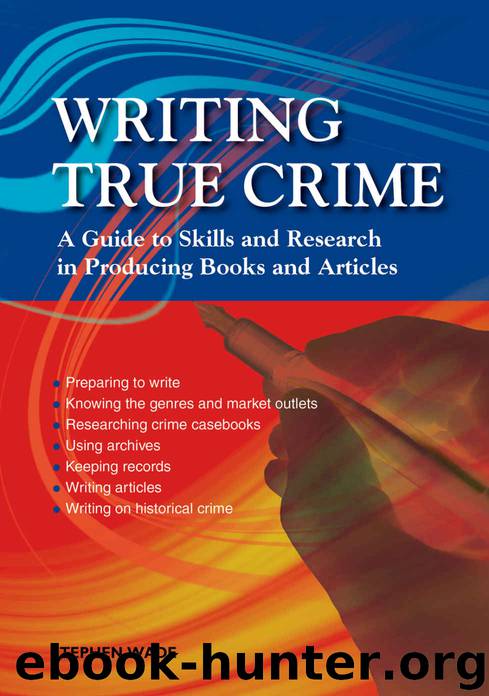Writing True Crime: An Emerald Guide (Emerald Guides) by Stephen Wade

Author:Stephen Wade [Wade, Stephen]
Language: eng
Format: azw3
Publisher: Emerald Guides
Published: 2018-08-22T16:00:00+00:00
Closure
Think about the finality of the classic crime story: of all the popular genres, true crime surely has a claim to have the most stunning repertoire of horrible, fateful finality in its writing: the Regency narrative of the scaffold has this in its barest form: a long and powerful account of the last hours of the condemned person, together with the effort to repent or feel remorse and the final moments on the scaffold with the noose ready to be tightened around the neck- this is closure.
But even a strong murder story may not end with execution or even life imprisonment of course. It may lead to the asylum and ‘Her Majesty’s Pleasure.’ Of course, there is a counter argument in murder tales and stories of other serious crime: the inner emotional and spiritual turmoil of the criminal imprisoned for life. In my experience, after working in prisons for six years, the general public have no real understanding of the nature of being in a cell, with no prospect of release, or even the experience of a prison cell with a release date known. The point is that your freedom has been taken away. There is no possibility of taking a walk to the corner shop or going to walk the dog in the park on a lovely summer day. No, there are high walls, gates with locks and a general air of depression. Days drag. As the poet Milton once wrote ‘Oh aching time, oh moments big as years!’ That would be the defining poetic line about incarceration.
This classic crime narrative closure is being stressed here because it is always an option. You might find more innovative ones, but the reader always enjoys the urge to reflect yet again on the truly awesome thought of a violent and judicial killing or the prospect of never seeing normal life ‘outside’ again.
Of course, the closure of the story is not necessarily an ‘ending’ and that word is somewhat outmoded and too simple now, when stories are very sophisticated and reading no longer an innocent pleasure for many of us. This means that a closure in true crime may be a simple suggestion that a person’s real punishment is going to be unavoidable, even in normal life. There are also the resources of the shifting point of view. Point of view (POV) opens up so many possibilities. In its simplest forms, it can offer the viewpoints of the victim, the offender, the bystander, the memoirist, an omniscient narrator and many more.
A lot depends, in a true crime closure, on whether you select an opening, uplifting closure or a hugely powerful dark one. These two closures of stories from a crime casebook show some interesting contrasts:
(a)
Barnetby, a small place where not much happens, was not exactly a village with a peaceful image at the time; not long after this, a young woman pulled up on a bike and walked into a post office, threatening to shoot someone. In the decade or so after
Download
This site does not store any files on its server. We only index and link to content provided by other sites. Please contact the content providers to delete copyright contents if any and email us, we'll remove relevant links or contents immediately.
And Here's the Kicker: Conversations with 21 Top Humor Writers on Their Craft by Mike Sacks(1048)
2120-2126 by Russell Fine(854)
2024-2120 by Russell Fine(800)
Letters to a young poet by Rainer Maria Rilke(701)
You Should Be Writing by Brenda Knight & Brenda Knight(700)
550 AP Calculus AB & BC Practice Questions by Princeton Review(693)
How Tell a Story and Other Essays by Mark Twain(675)
Reading for the Plot by Peter Brooks(667)
Poetics (Penguin Classics) by Aristotle(631)
Cultures and Beyond (The Art of World Building Book 3) by Randy Ellefson(596)
Improve Your Writing with NLP by Judith Pearson(592)
The Story Works Guide to Writing Point of View: How to harness the power of POV and write amazing narratives. (The Story Works Guide to Writing Fiction Book 2) by Winternheimer Alida(583)
Letters to a Young Poet (Rediscovered Books) by Rainer Maria Rilke(571)
Odessa Stories by Isaac Babel(554)
Story Structure Architect by Schmidt Victoria Lynn(551)
Mastering the Process by Elizabeth George(550)
The Hidden Writer by Alexandra Johnson(549)
Cracking the AP English Literature & Composition Exam, 2015 Edition by Princeton Review(543)
Figure It Out by Wayne Koestenbaum(535)
